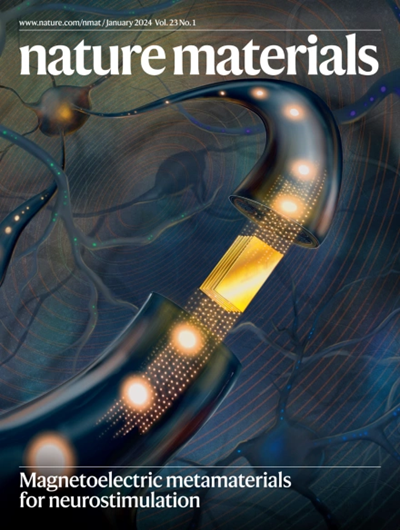有机自由基半导体中本征分子间光诱导电荷分离。
IF 38.5
1区 材料科学
Q1 CHEMISTRY, PHYSICAL
引用次数: 0
摘要
基于三(2,4,6-三氯苯基)甲基(TTM)自由基的有机自由基在自旋双重态流形中显示出有效的激子光致发光,但其在电荷光产生方面的潜力尚未得到充分的研究。当TTM接触时,光激发产生TTM阴离子-TTM阳离子对。它们可以辐射衰减或在电场偏压下完全分离。我们使用三苯基取代的TTM (P3TTM),其中苯基端基增强了分子间的相互作用。在宽能隙有机半导体基质中的稀释(5 wt%)薄膜中,我们观察到激发自由基在645 nm处产生的快速光致发光,以及在800 nm处由于P3TTM阴离子-阳离子对的重组而产生的超过1 μs的延迟成分。用100% P3TTM二极管结构进行的光电流测量显示,反向偏压下电荷收集效率接近于单位。我们发现了“同质结”分子间电荷分离,当阴离子上非键自由基的双占据能级的额外能量低于双激子的能量时,这种分离就成为可能。这为利用单材料分子半导体进行光收集提供了可能性。本文章由计算机程序翻译,如有差异,请以英文原文为准。
Intrinsic intermolecular photoinduced charge separation in organic radical semiconductors.
Organic radicals based on tris(2,4,6-trichlorophenyl)methyl (TTM) radicals show efficient photoluminescence from excitons in the spin-doublet manifold, but their potential in charge photogeneration remains unexplored. Here we report that when TTMs are in contact, photoexcitation generates TTM anion-TTM cation pairs. These can decay radiatively or be fully separated under an electric field bias. We use a triphenyl-substituted TTM (P3TTM) in which the phenyl end groups enhance intermolecular interactions. In dilute (5 wt%) films in a wide-energy-gap organic semiconductor host, we observe prompt photoluminescence from the excited radical at 645 nm, and a delayed component, beyond 1 μs, at 800 nm due to recombination of P3TTM anion-cation pairs. Measurements of photocurrent made with diode structures with 100% P3TTM showed close-to-unity charge collection efficiency in reverse bias. We have found 'homojunction' intermolecular charge separation, made possible when the extra energy for double occupancy of the non-bonding radical level on the anion is lower than the energy of the doublet exciton. This opens possibilities for light harvesting using single-material molecular semiconductors.
求助全文
通过发布文献求助,成功后即可免费获取论文全文。
去求助
来源期刊

Nature Materials
工程技术-材料科学:综合
CiteScore
62.20
自引率
0.70%
发文量
221
审稿时长
3.2 months
期刊介绍:
Nature Materials is a monthly multi-disciplinary journal aimed at bringing together cutting-edge research across the entire spectrum of materials science and engineering. It covers all applied and fundamental aspects of the synthesis/processing, structure/composition, properties, and performance of materials. The journal recognizes that materials research has an increasing impact on classical disciplines such as physics, chemistry, and biology.
Additionally, Nature Materials provides a forum for the development of a common identity among materials scientists and encourages interdisciplinary collaboration. It takes an integrated and balanced approach to all areas of materials research, fostering the exchange of ideas between scientists involved in different disciplines.
Nature Materials is an invaluable resource for scientists in academia and industry who are active in discovering and developing materials and materials-related concepts. It offers engaging and informative papers of exceptional significance and quality, with the aim of influencing the development of society in the future.
 求助内容:
求助内容: 应助结果提醒方式:
应助结果提醒方式:


